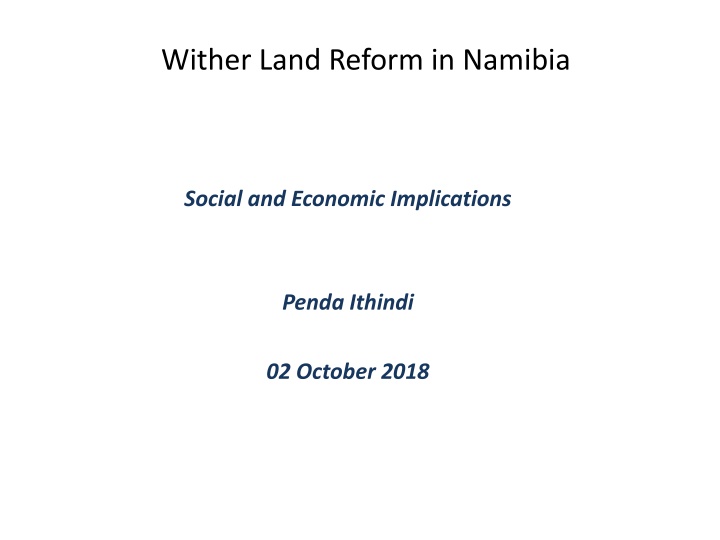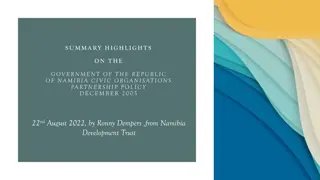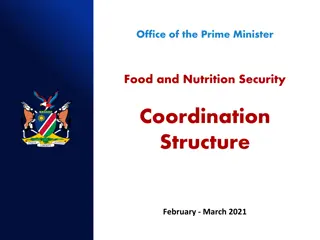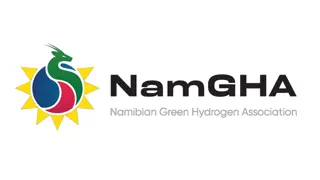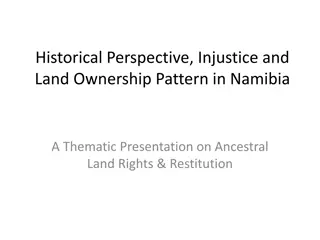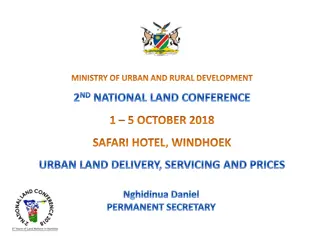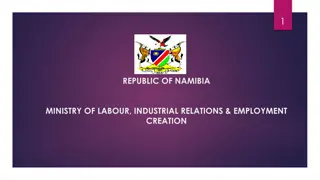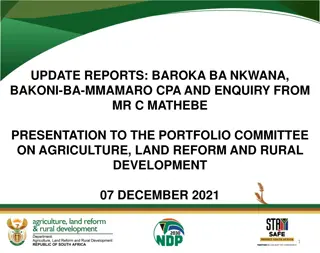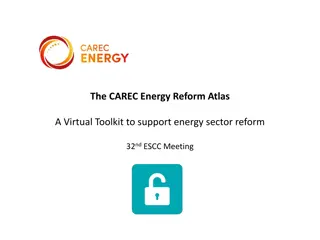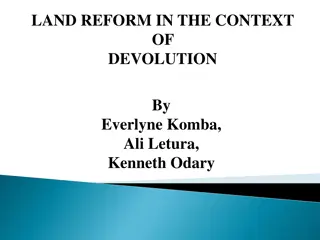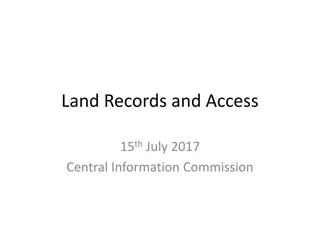Implications of Land Reform in Namibia: Social and Economic Insight
Land reform in Namibia is crucial for inclusive growth and shared prosperity, with access to land being a key factor. Productive land usage can lead to wealth creation and social development. The importance of agriculture in the economy is highlighted, along with the need for skilled farmers and a secure land tenure system. The success of land acquisition programs hinges on various factors, including economic viability, intergenerational equity, and balanced sustainable development. Progress indicators reveal significant public expenditure in acquiring land, reflecting efforts towards reform.
Download Presentation

Please find below an Image/Link to download the presentation.
The content on the website is provided AS IS for your information and personal use only. It may not be sold, licensed, or shared on other websites without obtaining consent from the author.If you encounter any issues during the download, it is possible that the publisher has removed the file from their server.
You are allowed to download the files provided on this website for personal or commercial use, subject to the condition that they are used lawfully. All files are the property of their respective owners.
The content on the website is provided AS IS for your information and personal use only. It may not be sold, licensed, or shared on other websites without obtaining consent from the author.
E N D
Presentation Transcript
Wither Land Reform in Namibia Social and Economic Implications Penda Ithindi 02 October 2018
Land acquisition, utilization and shared prosperity Land is a productive asset. When acquired and put to productive use such land can contribute to wealth creation and social development and transformation Access to land, is a necessary condition for inclusive growth, shared prosperity and making a dent on the triple challenges of unemployment (34%, 43%), poverty (17.2%) and inequalities (0.56) All most everyone aspires to have land. But access alone does not unleash land productivity. It is the labour, investments, skills and specialization which, when applied, unlocks land productivity and leads to the flow of net economic gains.
Share of agriculture and growth rates Agric share of GDP is falling Real growth volatile & diminishing 8.0 30.0 7.1 7.0 6.0 20.0 4.5 5.0 4.0 10.0 3.0 2.0 1.0 - 0.0 (10.0) Agriculture and forestry (20.0) Livestock farming Crop farming and forestry Linear (Agriculture and forestry) (30.0) Has shed jobs, productivity stagnant or falling, decreasing returns to scale The 2018 Consensus should not, at the very least, worsen but improve this outcome
Basic Requirements for a successful land acquisition/reform program o Existence of a capable mass of enterprising farmers and individuals with economic motive to utilize the land gainfully, o Ability to utilize the land resource profitably in a commercial sense or gainfully from broader economic perspective (managerial, technical skills), o A predictable rights-based system and security of tenure or lease with reasonable duration to serve as incentive for individuals and economic agents to invest and produce, o increased flow of net economic gains from acquired ownership or lease with intergenerational equity; thus, lifting people out of poverty and affording basic social amenities. Well-researched safeguards needed to avoid systematic meltdown o Optimal land size to warrant investments for economic viability and full capacity utilization of possessed or acquired land, o taking into consideration the country special circumstances, given the political economy of the land question. o the land reform agenda should seek to achieve a balance across the dimensions of sustainable development, that is, economic, social & environmental, with intergenerational equity.
Wither Land Reform in Namibia: Progress and Performance Indicators Based on available evidence, the following evidence emerge:- o About N$1.89 billion in public expenditure was made to acquire at least 549 commercial farms or some 3.2 million hectres of land under the willing buyer-willing seller principle. This is 0.1% of GDP, or some N$70.0 million annually over the past 27 years. o Affirmative loans extension for the same purpose were about N$1.4 billion for a total of 442 farms (6.0 million hectre) purchases?. o In total, this is N$3.2 billion in direct public spending over the past 27 years (NRP and AALS), averaging 0.2% of GDP or N$120 million annually. o As an Upper Middle Income Country, we have spare capacity to do better in terms of public expenditure towards the program, by prioritizing better within available resources. Multiple funding options can be considered and a case for some form of a targeted wealth tax can be made. o In respect to urban land, the binding constraints are mainly the supply and affordability of serviced land. This supply side constraint is exacerbated by high unemployment and low income levels at the bottom of the pyramid. Strategies for inclusive growth, private sector jobs and skills development are important
Socio-economic Implications: Land Reform and urban land delivery From economic perspective, the success of the reform depends on the degree to which the reform leads to increased flow of net economic benefits in terms of per capita income, jobs, profitability and increased productivity and social welfare. o Impact on net economic gains: A reform program which results in diminishing or dissipation of net economic gains such that aggregate output, income and productivity fall in the long-term is bad economics and neither poverty reducing nor welfare enhancing. Namibia should avoid to enact popular reforms with unpopular long-term economic outcomes. Impact on investment (realized and potential): The reform should provide a conducive environment how realized investment can continue to earn a return and an attractive environment for potential investment. It is perhaps this consideration which informed the willing buyer, willing seller principle and expropriation with just compensation. o o Market certainty and investor confidence: No doubt, the systematic and phased approach to land reform in Namibia has provided market certainty and investor confidence and predictability. We should keep in mind these trade-offs as a small open economy, highly vulnerable to shocks and needing to improve its competitiveness as part of its growth strategy. o Economic incentive: A rights-based system with a reasonable duration or term is the basis for creating economic incentive to invest, innovate and produce.
Socio-economic Implications: Summary From an economic perspective, the following recommendations emerge: o Implementation of the 2018 Consensus should result in the increase in the net economic benefits for Namibia and Namibians, i.e sector output must increase in quantity and quality, increased per capita income, jobs and further reduction of poverty and inequalities. o For commercial agricultural land, the allocation criteria should assess the ability to utilize land gainfully, acquisition should be accompanied by time-bound post-resettlement support and effective M&E. Full capacity utilization is key o A rights-based system, with a predictable security of tenure is indispensable to attract individual capital investments, o A package of funding mechanisms is needed to deliver better results. An Upper Middle Income Country has more spare capacity to implement redistributive policies and this is an appropriate avenue some form of a targeted Wealth tax, o An attractive and competitive domestic investment climate is key to Namibia s economic governance and pathway to inclusive growth, job creation and eradication of extreme poverty. o We should address the supply side constraints on urban land delivery. While doing so, an effective strategy lies in creating gainful employment and opportunities for self-employment.
